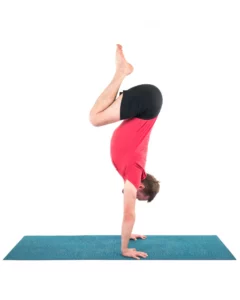Learn the Secret of Transitioning from Upward Facing Dog to Downward Facing Dog in Yoga

Article At A Glance
Transitions in yoga practice often take time and patience. Here’s a step-by-step guide, with a video included, for transitioning from Downward Facing Dog to Upward Facing Dog. Take your time and enjoy!
A student of mine recently said: “I’d love a tip on how to transition my feet from Plank to Upward Dog, then Downward Dog. I always have difficulty rolling my feet from Plank to Upward Dog, and when I ‘fudge it,’ I worry I’m doing it wrong.“
This is a great question! And don’t worry, Anonymous; you aren’t alone: This is a really difficult move, and it took me (and many other yogis I know!) years of practice to smoothly transition to Downward Facing Dog. So, don’t stress if you don’t get it right away. As long as you aren’t injuring yourself the way you’re currently practicing, just view it as a step in the process, and keep working on it. As with everything, eventually, it will come with practice!
How to Gently Transition From Plank With Your Feet
First, warm up your feet! Feet are delicate and deserve our respect, so it’s a good idea first to establish that your feet and ankles have the flexibility to practice this transition without injury.
Next, do a practice run. Once your feet and ankles are warmed up, you can work on transitioning your toes from a flexed to a pointed position to make sure your feet and ankles are strong and flexible enough to do this comfortably. To isolate your feet from the rest of the transition, do this from Plank Pose.
- Start in Plank Pose, with your toes tucked under, and press your heels back strongly.
- Shift your weight forward a tiny bit, lift from your core, and come up onto your tiptoes. Don’t try to roll your feet over yet – just see how high you can come onto tiptoes, hold for a breath, and then come down. Do this a few times.
- Finally, come up onto the very tips of your toes and then gently shift your pelvis forward until you roll over onto the tops of your feet. You may want to practice this with your hands forward of your usual alignment to maintain your stability. Practice this until it feels smooth and comfortable.
If your toes don’t feel comfortable rolling over, don’t force it. The feet are delicate, so be careful!

How to Transition From Plank to Chaturanga Dandasana to Upward Facing Dog
Next, it gets a little more challenging because in between Plank and Upward-Facing Dog, we have the Four-Limbed Staff Pose, Chaturanga Dandasana – a pose that requires a great deal of strength.
For this exercise, use a yoga block (or something equivalent, like a small ball or box) that you can squeeze between your thighs. This isn’t strictly necessary, but it helps by keeping your legs engaged and, therefore, encourages you to move from your core and pelvis.
The key thing to remember here is to originate the movement from your pelvis. Think of your pelvis as the engine that is driving the movement. Try to move just your pelvis, and the rest of your body will follow.
- Place your yoga block between your thighs and come into Plank Pose. Set your mental mantra to move from your pelvis, and as you inhale, lift (from your core!) up onto your tiptoes.



- Begin to exhale and lower yourself as far down into Chaturanga as you can hold for a few seconds – it doesn’t have to be all the way! Keep lifting as high as you can onto the tips of your toes and neutralize your neck. Continue to squeeze your block! This puts you in the perfect preparatory position to move forward into Upward Facing Dog.

- As your exhalation reaches empty, look forward, lift strongly from your core, and move your pelvis forward while pressing into your hands to straighten your arms. Open your chest and elongate your spine. With luck – and practice! – your toes will slide over at the last second as you go forward.


How to Transition Back to Downward Facing Dog
The final step is to return this from Upward Facing Dog to Downward Facing Dog. Again, focus on your pelvis as the origin of the movement.
- From Upward Facing Dog, begin to exhale. Press into your arms and as you near the end of your exhalation, strongly suck your belly button up and lift your pelvis UP and back. As you come up to a Plank-like position, you will come toward a full extension of your ankles, which can be uncomfortable, so try to make this a smooth, continuous movement.

- Before you think about going all the way back, try to get as high as you can onto the tops of your feet as you lift your hips up. When you can go no higher, send your hips back, and your toes will have nowhere to go but up and over! If they don’t quite go together, roll them over one at a time but practice alternating which foot goes first.

Here are a Few Extra Transition Tips:
- Keep your core strongly engaged by lifting your belly button toward your spine.
- Synchronize your hardest movements with the end of your exhalation, and move when your breath is empty. This automatically engages your abdominal and pelvic lifts, which will complement these movements.
- Try tiny variations in the position of your hands. While the general guideline is to line your hands up directly under your shoulders, a centimeter forward or back can really make the difference in finding the “sweet spot” that will serve you in both Chaturanga and Upward-Facing Dog.

Video Tutorial: Upward Facing Dog to Downward Facing Dog



